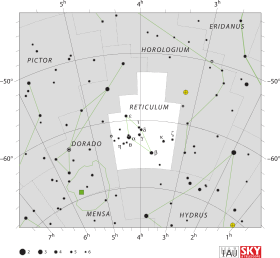Kappa Reticuli
Kappa Reticuli (κ Reticuli) is a binary star[3] system in the southern constellation of Reticulum. It is visible to the naked eye, having a combined apparent visual magnitude of +4.71.[2] Based upon an annual parallax shift of 46.12 mas as seen from Earth,[1] it is located 71 light years from the Sun. Based upon its space velocity components, this star is a member of the Hyades supercluster of stars that share a common motion through space.[14]
 | |
| Observation data Epoch J2000.0 Equinox J2000.0 (ICRS) | |
|---|---|
| Constellation | Reticulum |
| Right ascension | 03h 29m 22.67724s[1] |
| Declination | −62° 56′ 15.0991″[1] |
| Apparent magnitude (V) | +4.71[2] + 10.7[3] |
| Characteristics | |
| Spectral type | F3 V[4] or F3 IV/V[5] + M1[6] |
| U−B color index | −0.04[2] |
| B−V color index | +0.39[2] |
| Astrometry | |
| Radial velocity (Rv) | +12.5±0.4[7] km/s |
| Proper motion (μ) | RA: +382.84[1] mas/yr Dec.: +373.05[1] mas/yr |
| Parallax (π) | 46.12 ± 0.13[1] mas |
| Distance | 70.7 ± 0.2 ly (21.68 ± 0.06 pc) |
| Absolute magnitude (MV) | +2.98[8] |
| Details | |
| κ Ret A | |
| Mass | 1.32[9] M☉ |
| Radius | 1.1[10] R☉ |
| Surface gravity (log g) | 4.31[9] cgs |
| Temperature | 6,796±231[9] K |
| Metallicity [Fe/H] | −0.07[11] dex |
| Rotational velocity (v sin i) | 13.5±0.7[12] km/s |
| Age | 848[9] Myr |
| κ Ret B | |
| Mass | 0.54[6] M☉ |
| Radius | 0.50[6] R☉ |
| Luminosity | 0.043[6] L☉ |
| Temperature | 3,733[6] K |
| Other designations | |
| Database references | |
| SIMBAD | data |
Houk and Cowley (1978) catalogued the yellow-hued[15] primary, component A, with a stellar classification of F3 IV/V,[5] indicating this is an F-type star that showing mixed traits of a main sequence and a more evolved subgiant star. Later, Grey et al. (2006) listed a class of F3 V,[4] suggesting it is an F-type main-sequence star. It is emitting a statistically significant amount of infrared excess, suggesting the presence of an orbiting debris disk.[16] The secondary, component B, is an orange-hued[15] star with a visual magnitude of 10.4 at an angular separation of 54 arc seconds from the primary.[3]
References
- van Leeuwen, F. (2007), "Validation of the new Hipparcos reduction", Astronomy and Astrophysics, 474 (2): 653–664, arXiv:0708.1752, Bibcode:2007A&A...474..653V, doi:10.1051/0004-6361:20078357.
- Johnson, H. L.; et al. (1966), "UBVRIJKL photometry of the bright stars", Communications of the Lunar and Planetary Laboratory, 4 (99): 99, Bibcode:1966CoLPL...4...99J.
- Eggleton, P. P.; Tokovinin, A. A. (September 2008), "A catalogue of multiplicity among bright stellar systems", Monthly Notices of the Royal Astronomical Society, 389 (2): 869–879, arXiv:0806.2878, Bibcode:2008MNRAS.389..869E, doi:10.1111/j.1365-2966.2008.13596.x.
- Gray, R. O.; et al. (July 2006), "Contributions to the Nearby Stars (NStars) Project: Spectroscopy of Stars Earlier than M0 within 40 parsecs: The Northern Sample I", The Astronomical Journal, 132 (1): 161–170, arXiv:astro-ph/0603770, Bibcode:2006AJ....132..161G, doi:10.1086/504637.
- Houk, Nancy; Cowley, A. P. (1978), "Michigan catalogue of two-dimensional spectral types for the HD stars", University of Michigan Catalogue of two-dimensional spectral types for the HD stars. Volume I. Declinations -90_ to -53_ƒ0, Ann Arbor: Dept. of Astronomy, University of Michigan, 1, Bibcode:1975mcts.book.....H.
- Gaidos, E.; Mann, A. W.; Lépine, S.; Buccino, A.; James, D.; Ansdell, M.; Petrucci, R.; Mauas, P.; Hilton, E. J. (2014). "Trumpeting M dwarfs with CONCH-SHELL: A catalogue of nearby cool host-stars for habitable exoplanets and life". Monthly Notices of the Royal Astronomical Society. 443 (3): 2561. arXiv:1406.7353. Bibcode:2014MNRAS.443.2561G. doi:10.1093/mnras/stu1313.
- de Bruijne, J. H. J.; Eilers, A.-C. (October 2012), "Radial velocities for the HIPPARCOS-Gaia Hundred-Thousand-Proper-Motion project", Astronomy & Astrophysics, 546: 14, arXiv:1208.3048, Bibcode:2012A&A...546A..61D, doi:10.1051/0004-6361/201219219, A61.
- Reiners, A. (January 2006), "Rotation- and temperature-dependence of stellar latitudinal differential rotation", Astronomy and Astrophysics, 446 (1): 267–277, arXiv:astro-ph/0509399, Bibcode:2006A&A...446..267R, doi:10.1051/0004-6361:20053911.
- David, Trevor J.; Hillenbrand, Lynne A. (2015), "The Ages of Early-Type Stars: Strömgren Photometric Methods Calibrated, Validated, Tested, and Applied to Hosts and Prospective Hosts of Directly Imaged Exoplanets", The Astrophysical Journal, 804 (2): 146, arXiv:1501.03154, Bibcode:2015ApJ...804..146D, doi:10.1088/0004-637X/804/2/146.
- Pasinetti Fracassini, L. E.; et al. (February 2001), "Catalogue of Apparent Diameters and Absolute Radii of Stars (CADARS)", Astronomy and Astrophysics (Third ed.), 367 (2): 521–524, arXiv:astro-ph/0012289, Bibcode:2001A&A...367..521P, doi:10.1051/0004-6361:20000451.
- Casagrande, L.; et al. (2011), "New constraints on the chemical evolution of the solar neighbourhood and Galactic disc(s). Improved astrophysical parameters for the Geneva-Copenhagen Survey", Astronomy & Astrophysics, 530 (A138): 21, arXiv:1103.4651, Bibcode:2011A&A...530A.138C, doi:10.1051/0004-6361/201016276.
- Ammler-von Eiff, M.; Reiners, A. (June 2012), "New measurements of rotation and differential rotation in A-F stars: are there two populations of differentially rotating stars?", Astronomy & Astrophysics, 542: 31, arXiv:1204.2459, Bibcode:2012A&A...542A.116A, doi:10.1051/0004-6361/201118724, A116.
- "kap Ret". SIMBAD. Centre de données astronomiques de Strasbourg. Retrieved 2017-07-14.
- Montes, D.; et al. (November 2001), "Late-type members of young stellar kinematic groups - I. Single stars" (PDF), Monthly Notices of the Royal Astronomical Society, 328 (1): 45–63, arXiv:astro-ph/0106537, Bibcode:2001MNRAS.328...45M, doi:10.1046/j.1365-8711.2001.04781.x.
- Streicher, Magda (December 2009), "Reticulum: The Celestial Crosshairs", Monthly Notes of the Astronomical Society of South Africa, 68 (11–12): 242–246, Bibcode:2009MNSSA..68..242S.
- Gáspár, András; et al. (May 2013), "The Collisional Evolution of Debris Disks", The Astrophysical Journal, 768 (1): 29, arXiv:1211.1415, Bibcode:2013ApJ...768...25G, doi:10.1088/0004-637X/768/1/25, 25.